The psychology of pricing is important.
Last month, I was a speaker at the Product Hunt Istanbul meetup with about 100 founders on pricing psychology, how to price a product, the psychology of pricing, and how to 2x revenue with pricing strategies.
I explained into the psychology of pricing, human behavior and cognitive biases, sharing psychological pricing examples, and in-depth psychological pricing strategies.
Watch the full talk on YouTube, or check out the blog post and transcript versions below.
(This video was translated and dubbed with AI.)
For the original (Turkish) version; watch TR
Table of Contents

1. Pricing psychology: 2 experiments with nudge and decoy effect
Pricing psychology: Influence the decision of potential customers with decoy effect in pricing
Now, let’s start with a quick question about pricing psychology. What do you think about this pricing strategy, and which one would you buy?

In this pricing approach, we tend to prefer the largest size because these prices suggest it. The package options can be small, medium, and large, but the prices below mostly push us to choose the largest one.
Which one would you buy at this pricing?
This was an example I saw on Twitter. Let’s imagine Twitter implemented the following pricing for all users and presented these options. Which one would you prefer? Package 1, Package 2, or Package 3?

In this scenario, Package 2 is the most ideal choice, as it offers a balanced set of features at a reasonable price. Package 1 is quite limited, serving as an anchor point. Package 2 provides an optimal choice, and while Package 3 offers additional features, the difference might not be significant enough to justify the higher price. Therefore, the tendency to choose Package 2 is much higher in this case.
2. Pricing psychology: The impact of behavioral science, psychology, and cognitive biases on human decisions.
How you design choices determines decisions and behaviors

In behavioral science and psychology, how you design choices determines decisions and behaviors. In essence, this is the core of the matter. Because one aspect of pricing is closely related to perception. In other words, we value something based on how we perceive it. Consequently, we assess its price accordingly.
Keeping toilets clean with a nudge: The fly in the urinal
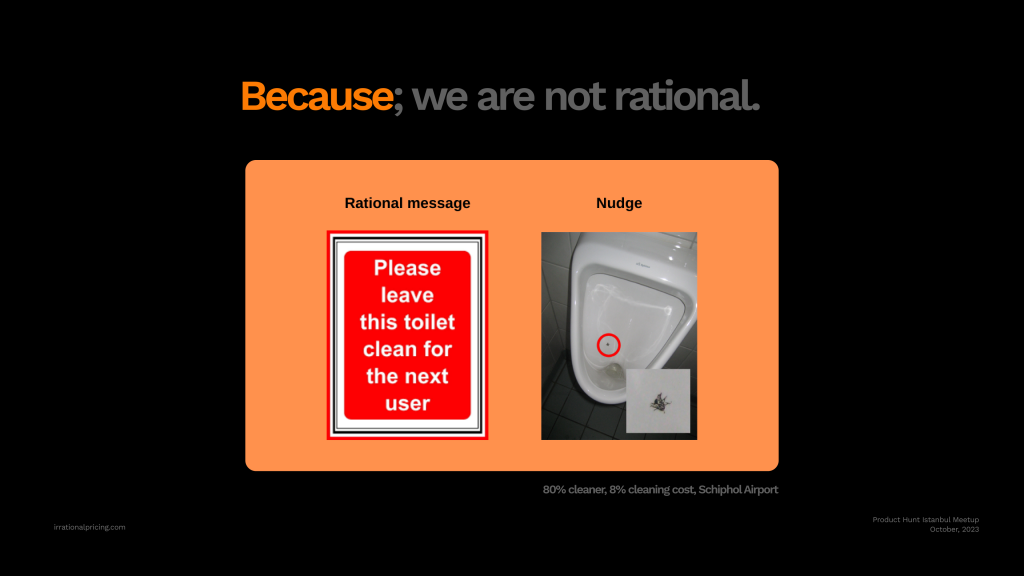
Examining the reasons behind this, if we are not rational, is one of the most ideal examples of our irrationality. Some of you might have come across this. It’s an example from the “Nudge” book, a study conducted at Amsterdam Airport. Women might not understand this because it can be a bit surprising. When a fly image is placed inside urinals, men tend to aim better, leading to a tendency to keep the restroom cleaner.
The reason for this is, we are not rational. One of the most ideal examples of our irrationality is right here. Some of you might have seen this before. This was mentioned in the Nudge book. An experiment conducted at Amsterdam Airport. Women might not understand this. Because they can be a bit surprised. When images of flies are placed in urinals, men tend to aim at them, making the restroom cleaner.
This example might seem a bit strange to women, but it’s true. And in this experiment, it’s actually observed that the restroom stays cleaner this way. This is one of the most common examples of nudges.
Reducing accidents with a nudge: Lane markings on the road
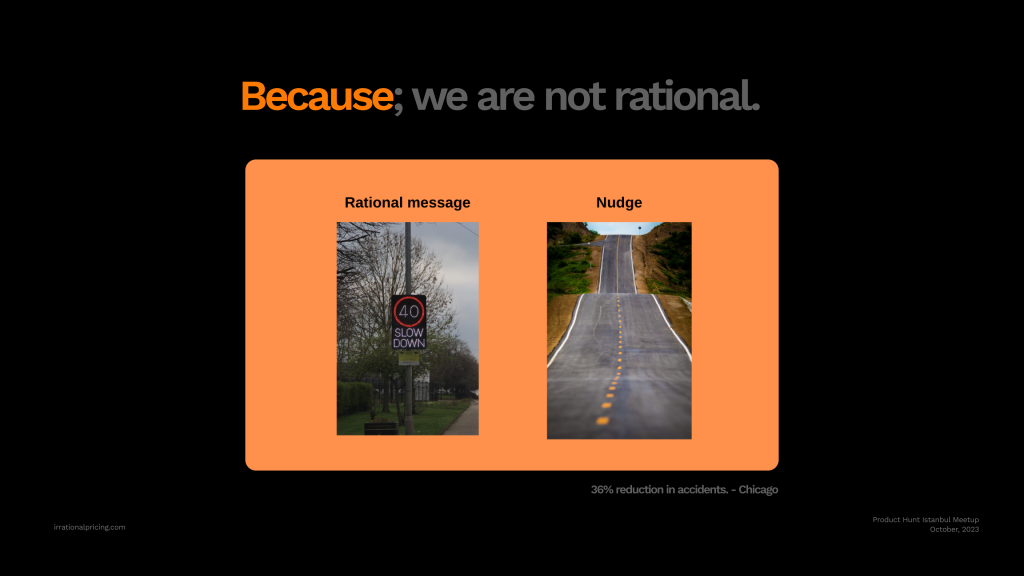
Another example is from Chicago. There are a lot of accidents at a particular curve. And the local authorities there implement a solution like this. They make the lane markings, as you see in the right visual, more frequent before approaching the curve. In other words, they draw those markings at closer intervals.
Therefore, if I’m going at 70 km/h, I perceive that I’m going faster because the lines are closer together. I automatically exhibit a reflex to slow down. And thanks to this, they managed to reduce accidents by approximately 36%. This is another example of nudging that we can provide.
3. Daniel Kahneman’s System 1 ve system 2 thinking for pricing
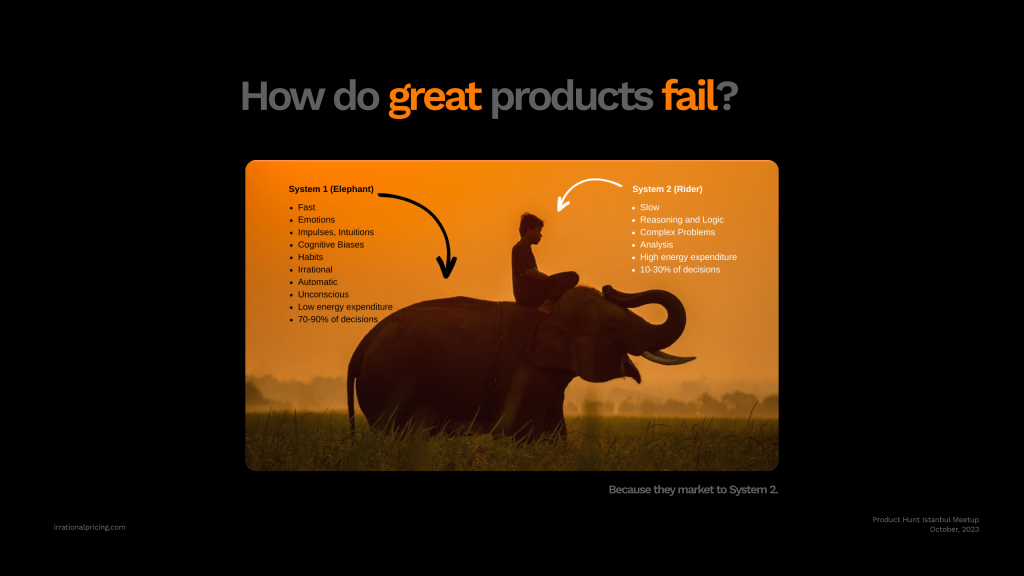
System 1 thinking for pricing
The person who explains this system best is Daniel Kahneman. He labels our brain’s and our thinking process as System 1 and System 2. System 1 is our fast-thinking side. It defines the irrational things we do, such as emotions, impulses, cognitive biases, habits, and so on.
System 2 thinking for pricing
System 2, on the other hand, is when we think slowly, our brain expends more energy, and we solve more complex problems. For example, when evaluating 10 different options, that’s where we engage System 2. And sometimes, it can make decision-making difficult due to the “Paradox of Choice.” Because the brain expends a lot of energy in those situations.
How do great products fail?
Why don’t rational messages work in marketing?
And most of the time, there are products that logically work well, but they aren’t liked, they don’t grow, they don’t get bought. Actually, they often market them to System 2. Jonathan Haidt, who explains System 1 and System 2 with the elephant and the rider analogy, addresses this in his book. With this analogy, he says; You can logically explain something to System 2. But that doesn’t mean you can move the elephant (the emotional, impulsive side). Smoking is bad, alcohol is bad, unhealthy eating is bad. There’s probably no one here who would deny these facts. But we can’t implement them. So, just because something is rational doesn’t mean we will do it. This analogy can serve as an example of why some good products don’t succeed, and don’t get purchased.
You’re leaving money on the table!
Join 500+ founders who have subscribed to the newsletter.
Join Pricing newsletter and learn from pricing case studies for $0
4. Pricing psychology examples
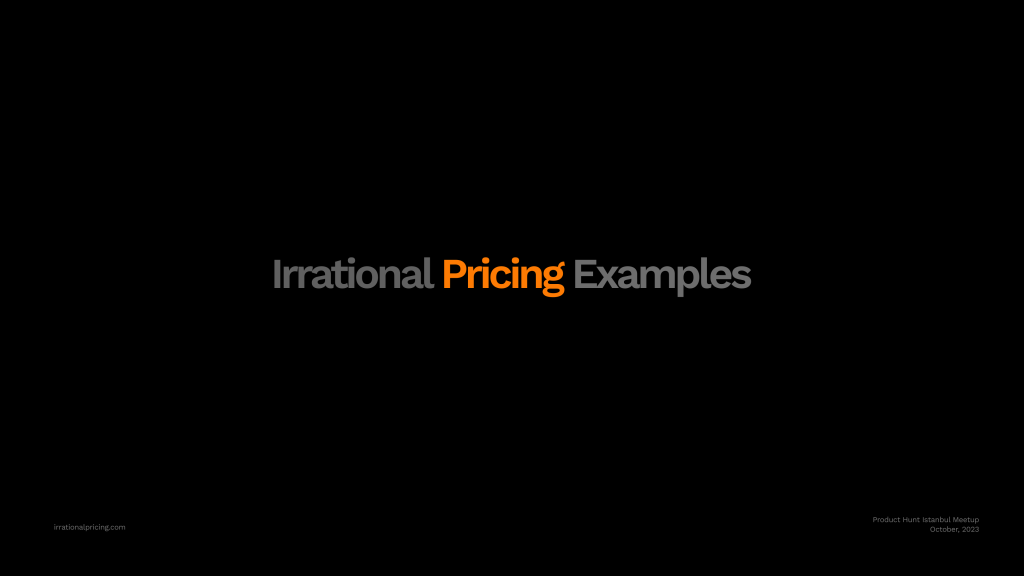
Pricing psychology: Influence decision of potential customers with framing effect in pricing.
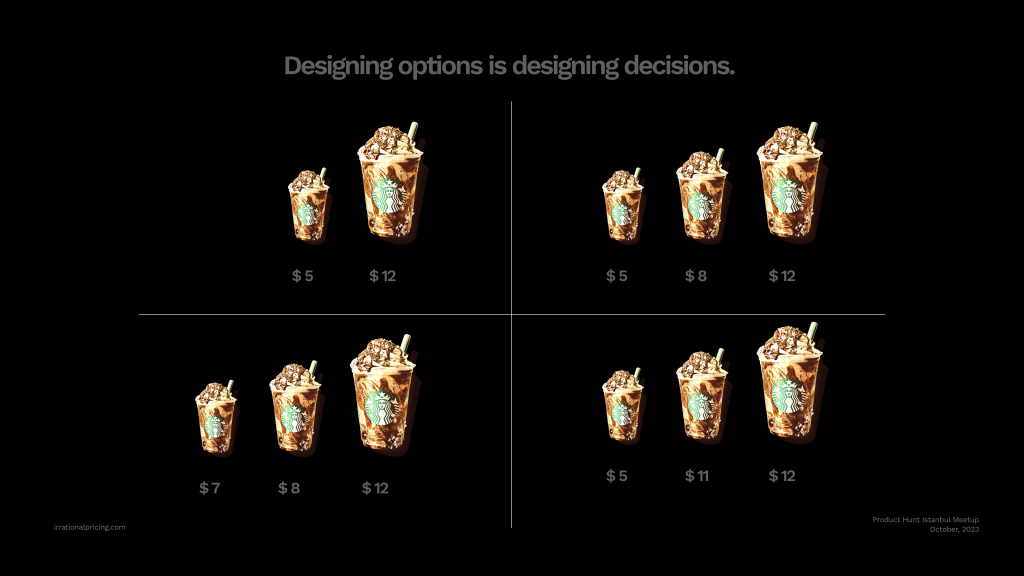
Now let’s continue with a few more examples.
Take the coffee experiment I showed you earlier. In that scenario, we are inclined to buy the third package, meaning the large-sized coffee. But if we frame these situations differently, as shown here, different outcomes emerge. In other words, the purchase rates change for each framing.
For example, if we offer 2 packages, one for $5 and another for $12, like the top left option, it becomes a bit more balanced. However, the $5 small-sized coffee will be more likely to be purchased.
But if we use a pricing strategy like the top right option, we can see that the $8 medium-sized coffee in the middle will be purchased more.
This is what we call the “framing effect.” It means we truly perceive the outcomes based on how we frame something. We can influence the results based on how we design and present options.
Pricing psychology examples 2:
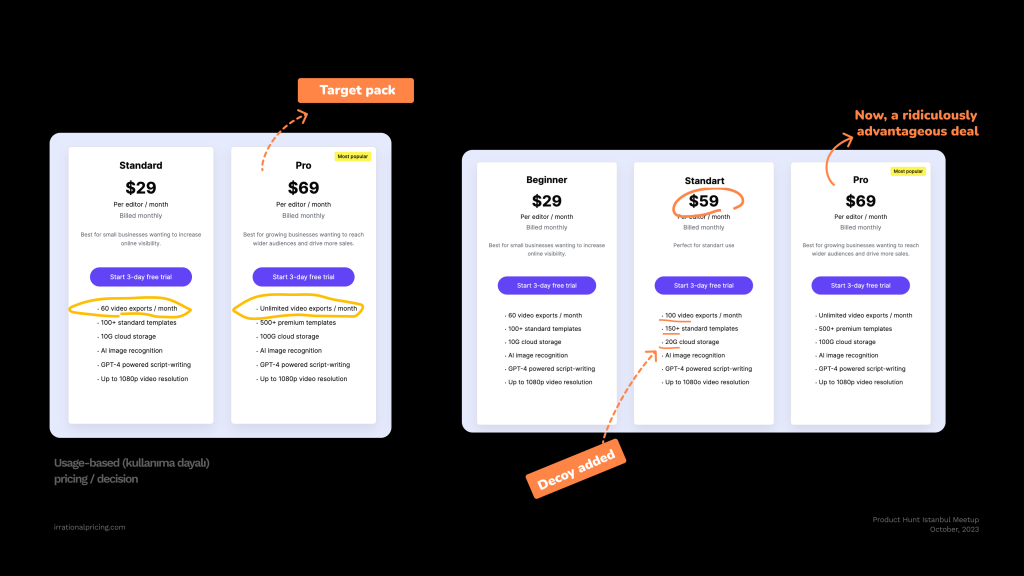
This is an example I saw on Product Hunt.
I don’t remember the name of the product right now, but I think it was a video content AI tool.
On the left, you can see their own pricing. They have two packages, one for $29 and another for $69. They’ve designed two different scenarios where users can get 60 video exports and unlimited video exports.
This pricing strategy is trying to convey the following message: “I actually want to sell you the Pro plan, but they don’t have a lot of evidence to support this argument.
Pricing psychology: Usage based decision in pricing and user perception without framing
Therefore, we tend to decide based on our usage scenario. Will I export fewer than 60 videos monthly, or will I export more? In other words, our decision-making tendency is based on actual usage.”
However, by making a small tweak to the pricing and designing it like the one on the right, the results can change. The pricing on the right is the one I designed.
I added a package next to the first one, where we can get 100 video exports for $59. Is it better to pay $69 for unlimited usage or $59 for 100 exports?
This way, we make the Pro package much more advantageous.
Pricing psychology: A ridiculously advantageous deal in pricing
One of the most ideal things in pricing is this: present an incredibly advantageous deal at the end. I want the user to come in, see a ridiculously advantageous offer, and then rationalize it.
Most of the time, we make decisions based on immediate reactions (System 1 thinking). But later on, we say, “Yes, I did the right thing.”
Decoy effect and rationalization in pricing decision
In reality, this process is called rationalization. We enjoy justifying and convincing ourselves about what we did. Therefore, an example on the right could significantly facilitate the transition to the Pro package for $59. We can call this the Decoy effect
Pricing psychology examples 3: Increased product revenue 135% with default effect in pricing
Our product is audit.landin.page
Let’s move on to the second example. This is our product, Audit. We’ve created a product that uses AI-based technology – mentioning AI is essential because it’s very popular right now – to analyze landing page copies. We examine landing page copies based on behavioral and psychological effects.
On the left, you can see the pricing section of our landing page.
Anchoring effect in Pricing psychology
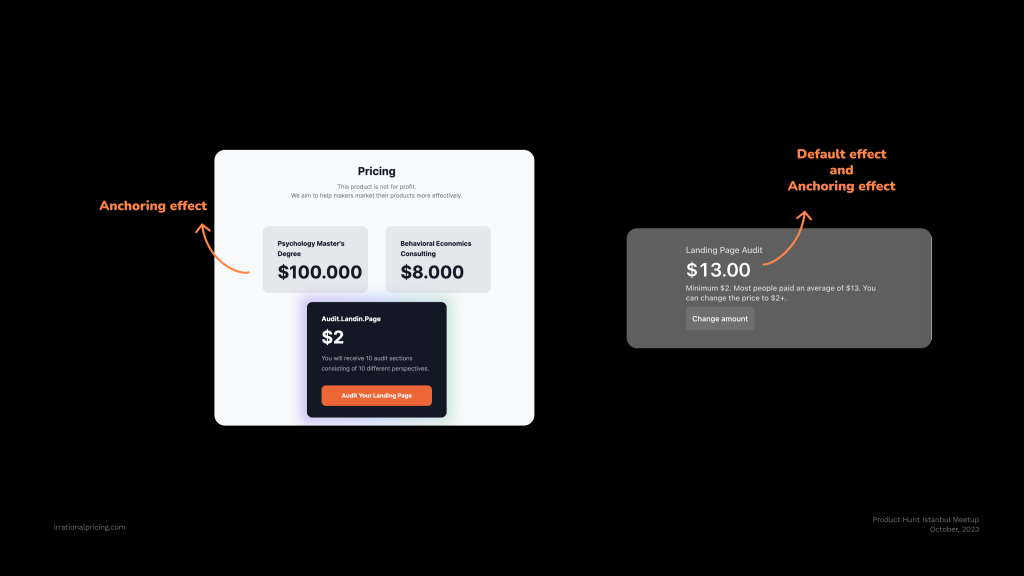
First, let me briefly explain the Anchor effect applied here. We’ve implemented two Anchors. Instead of using this tool, you could hire a consultant for $8,000.
Alternatively, you could spend $100,000 to learn this information. But we say, this product is only $2.
It’s worth mentioning that I don’t usually recommend low pricing. This product is the first piece of a series of products we will produce. We used it as a lead magnet, so to speak.
Default effect in Pricing psychology
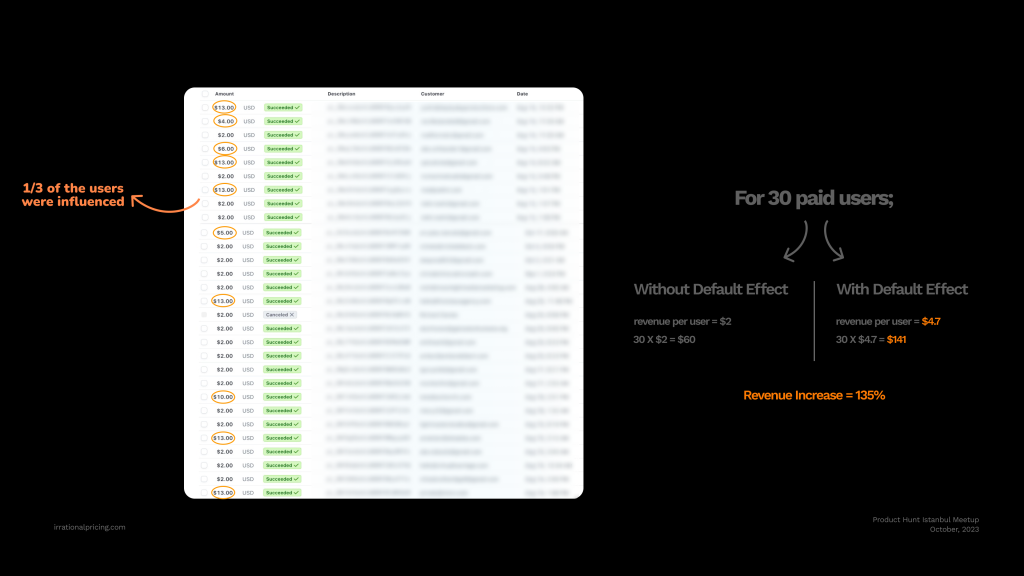
That’s why we priced it at $2. The crucial point here is this: we’re offering this product for $2 on the landing page. When the user goes to the checkout, they encounter the Stripe screen on the right, showing $13.
Welcome to the Default effect. We shared this product with our beta users first and, based on the feedback, we reached an average willingness to pay of $10. We said the product is $2. However, people are willing to pay an average of $13 for this product. The Stripe screen displays $13, but you can change it to $2 or any other amount.
Increased product revenue 135% with pricing psychology and default effect
We conducted this study, and these are the results of our sales. The ones marked in yellow are the users who paid more than $2. One-third of the users were influenced by the Default effect. Some paid $4, some paid $5, some paid $13, some paid $6, and some paid $10. We applied this method.
Of course, it’s important to note the sample size here. As the sample size increases, this ratio might decrease. Right now, we are evaluating based on the current situation, and I can say it’s one-third of the users.
The results for 30 users were as follows: the product is $2. Normally, we should have earned $60 with 30 users. But with these results, we have an average revenue of $4.7 per user, totaling $141. This has led to a 135% increase in revenue.
Pricing psychology examples 4: Scarcity bias, Urgency bias and loss aversion bias in Pricing
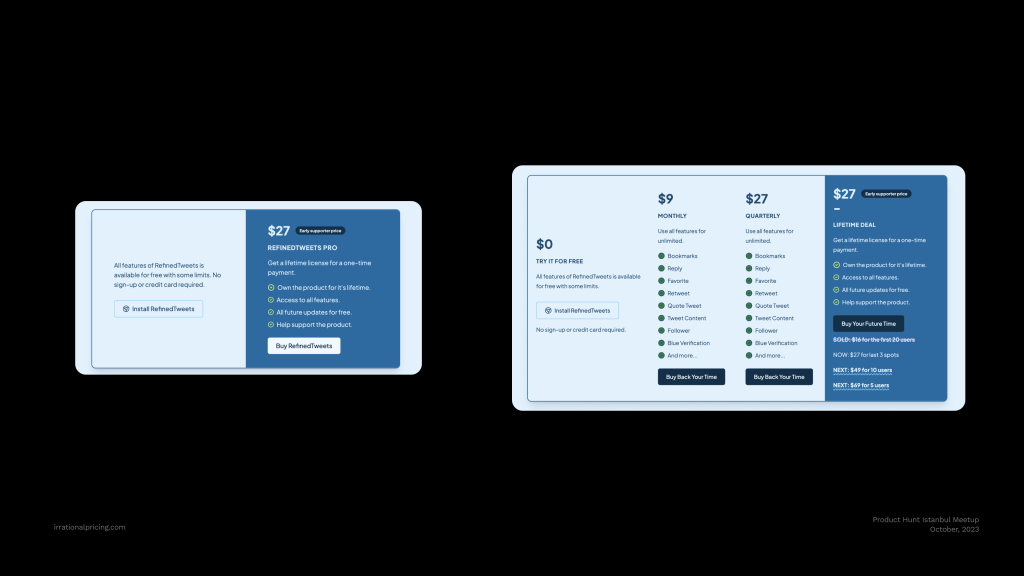
Now let’s move on to our final example. This case is a bit detailed, but I’ll focus on 1-2 critical points because I designed this using approximately 10 cognitive biases and behavioral effects.
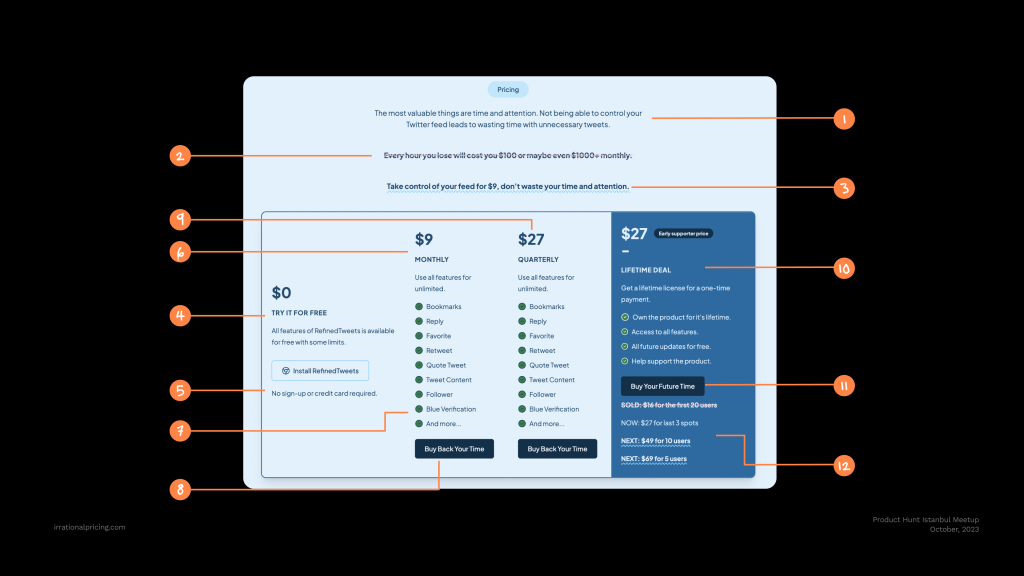
Read the entire case study.
Cracking the Pricing Code with Tiered Pricing Strategy
On the left, you can see the product itself. It’s a product that enhances this Twitter feed. It has an extension, which is free and can be used with limitations, and there’s also a pro package.
I usually don’t recommend lifetime deals. However, the friend who developed this product opted for this strategy and wants to sell it for $27. Our target package here is $27.
Framing effect in Pricing psycholoy
We need to make the $27 lifetime deal much more advantageous. That’s why I designed the pricing like this: You should pay $9 monthly for this product, or you can make a one-time payment of $27 for 3 months. Additionally, you can purchase the lifetime deal for $27.
Therefore, compared to the existing scenario on the left, the “lifetime” option on the right becomes much more compelling and profitable.
Pricing psychology and BJ Fogg behavior model
Another critical point here is the elements we see in this section. BJ Fogg is a behavior change expert. According to his behavior change model, three elements need to align for a person’s behavior to change.
Motive is essential; obstacles need to be removed, and thirdly, there’s the “trigger” – the action point. Most landing pages face a common handicap: the user might be motivated, and we might have removed obstacles or uncertainties. However, the crucial question remains: why should the user buy now?
If we don’t sell to them at this moment, the hype will fade away. Of course, this situation is a bit different for B2Bs. We can set B2Bs aside for this matter. Our main goal is to sell the product while the hype is high and the users are motivated.
Pricing psychology: Scarcity bias, Urgency bias and loss aversion bias in Pricing
Certainly, the call to actions is crucial, but there are two more important aspects. The first one is “Urgency Bias,” and the second one is “Scarcity.”
We need to create a sense of scarcity and urgency to prompt immediate action. We’re actually creating this at the bottom right corner. We can call it layered pricing, specifically inside the lifetime deal. In the past, we sold this package to 20 users for $16. Now we’re selling it for $27. However, we have limited spots available. This also acts as a form of punishment.
Therefore, not only “urgency” or “scarcity” works here but also the cognitive bias of “loss aversion.” The most effective cognitive bias we operate on is avoiding losses; our brain functions to keep us alive by avoiding losses. Hence, we say, if you miss out on $27, you’ll have to pay $49.
And there’s a limit to that too. In the next step, both the price increases and the limit decreases. So, while making the $27 package more appealing to the user, we simultaneously create urgency for them to act now.
5. Pricing Mistakes: Mistakes to avoid in your pricing.
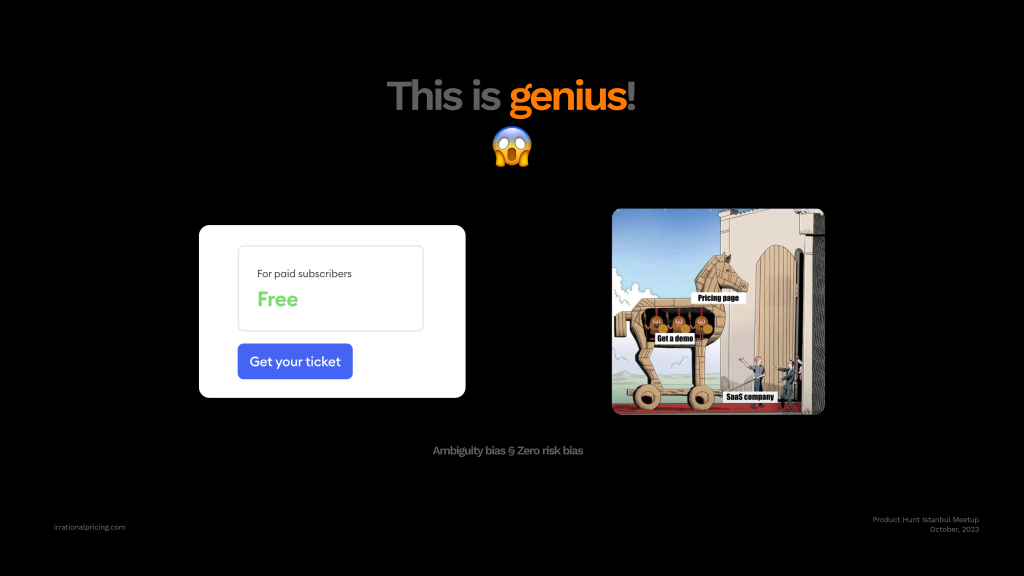
Ambiguity effect in Pricing psychology
These are two incredibly brilliant examples. I mean, they could be very brilliant. But you definitely shouldn’t do them. On the left, from Superpeer, I don’t know how they came up with this pricing after how much alcohol. but it definitely shouldn’t have been done.
“Free for paid subscribers.” This actually works on the ambiguity bias. It serves no purpose other than creating confusion.
Zero risk bias in pricing psychology
The example on the right is something we see in most SaaS products.
Pricing pages without pricing
It’s another example of what shouldn’t be done. pricing pages without pricing. It’s truly unbelievable. I mean, why? Why would you put a pricing page without pricing? I wanted to add these two common examples to help you avoid them.
Pricing psychology: 200+ cognitive biases in pricing
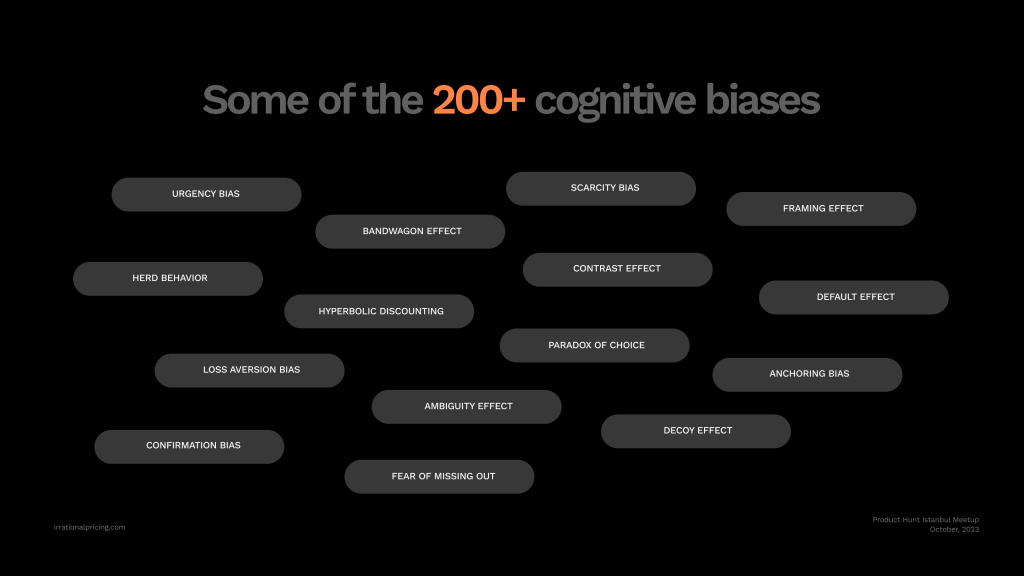
There are more than 200 cognitive biases that have significant behavioral impacts, and the most important ones, especially in the context of pricing, are these.
I will share the sources shortly. If anyone is interested in this topic, I can also share the presentation. These are the behavioral effects that influence us the most.
As I mentioned, they are closely related to our perception, the value we assign, and therefore, what we are willing to pay.
Pricing pscyhology: Irrational Pricing framework
Now, we are in search of a framework. In other words, we are often looking for tricks. We are searching for methods that work. We always delve into the understanding of these.
This is the most straightforward framework related to how pricing should be designed. Especially for a more value-based pricing approach. I should also mention here that I’m not talking about the pricing methods you can find with a quick Google search.
These are examples that you won’t often come across, ones you won’t be able to find easily. Simple Google searches can yield results on classic pricing methods.
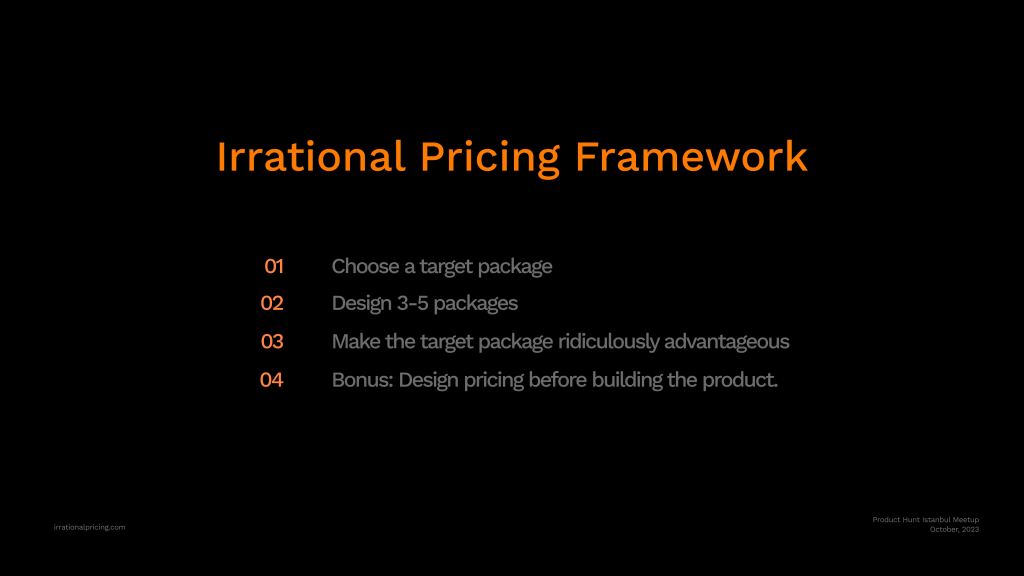
To briefly touch upon the framework:
1 target package in pricing
First, choose one package. You should have one target package in mind. I want to sell this package to the user.
3,4 or 5 package in pricing
Later on, you should have 3, 4, or 5 packages. Having just 1 or 2 packages is not very ideal. Because you might not shape the pricing packages well enough.
Or if you offer more than 5 packages, it can lead to effects like the “paradox of choice,” making decision-making more difficult. Therefore, having 3, 4, or 5 packages is ideal. And you should have one target package.
A ridiculously advantageous deal in pricing
And you need to make that target package, the one you want to sell, ridiculously advantageous. I just explained System 1 and System 2 a moment ago. The user should be able to notice this when looking at it with System 1, that is, immediately.
The user should think, “this package is very advantageous, and I shouldn’t miss it; this is really a great deal.” And then, the user should rationalize this decision with System 2.
Because if they don’t rationalize it, the likelihood of them coming back as unhappy users is very high.
Firstly building a pricing later develop product
As a bonus, we can also add this: I always recommend this to those in the product idea or development stage. Take a piece of paper and a pen and write a landing page.
Because you notice a lot of things while writing that landing page. What should be the Unique Value Proposition of the product, how should you frame this product, what are the benefits of this product, and so on. And you get the chance to shape the product accordingly.
In addition, designing the pricing will make your job easier on the technical side. So first, think about “how can I sell this product?” and imagine a pricing.
Then, it will help you develop the product.
Research about Pricing psychology
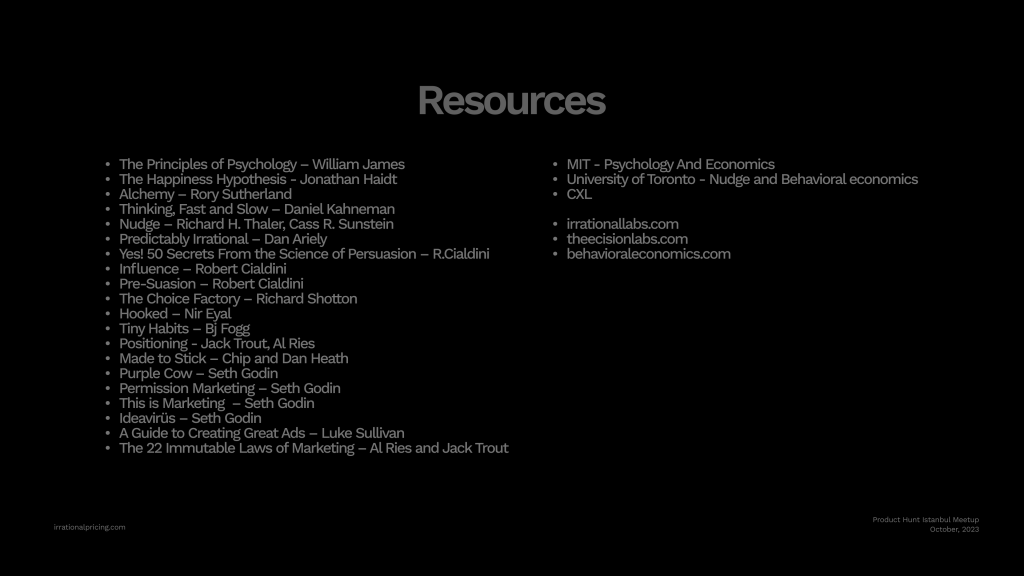
These are the resources.
- The Principles of Psychology – William James
- The Happiness Hypothesis – Jonathan Haidt
- Alchemy – Rory Sutherland
- Thinking, Fast and Slow – Daniel Kahneman
- Nudge – Richard H. Thaler, Cass R. Sunstein
- Predictably Irrational – Dan Ariely
- Yes! 50 Secrets From the Science of Persuasion – R.Cialdini
- Influence – Robert Cialdini
- Pre-Suasion – Robert Cialdini
- The Choice Factory – Richard Shotton
- Hooked – Nir Eyal
- Tiny Habits – Bj Fogg
- Positioning – Jack Trout, Al Ries
- Made to Stick – Chip and Dan Heath
- Purple Cow – Seth Godin
- Permission Marketing – Seth Godin
- This is Marketing – Seth Godin
- A Guide to Creating Great Ads – Luke Sullivan
- MIT-Psychology And Economics
- University of Toronto – Nudge and Behavioral economics
- CXL
- irrationallabs.com
- theecisionlabs.com
- behavioraleconomics.com
- Ideavirüs – Seth Godin
- The 22 Immutable Laws of Marketing – Al Ries and Jack Trout
Here are marketing books and psychology, behavioral science books.
On the left side, there are books. I recommend reading them for those interested in these topics. They are somewhat beginner-friendly. There are books that encompass both behavioral science and marketing.
Here are course and sources about marketing and psychology
On the right side, there are the trainings I have taken and the sources I follow.
Join Irrational Pricing Newsletter at irrationalpricing.com
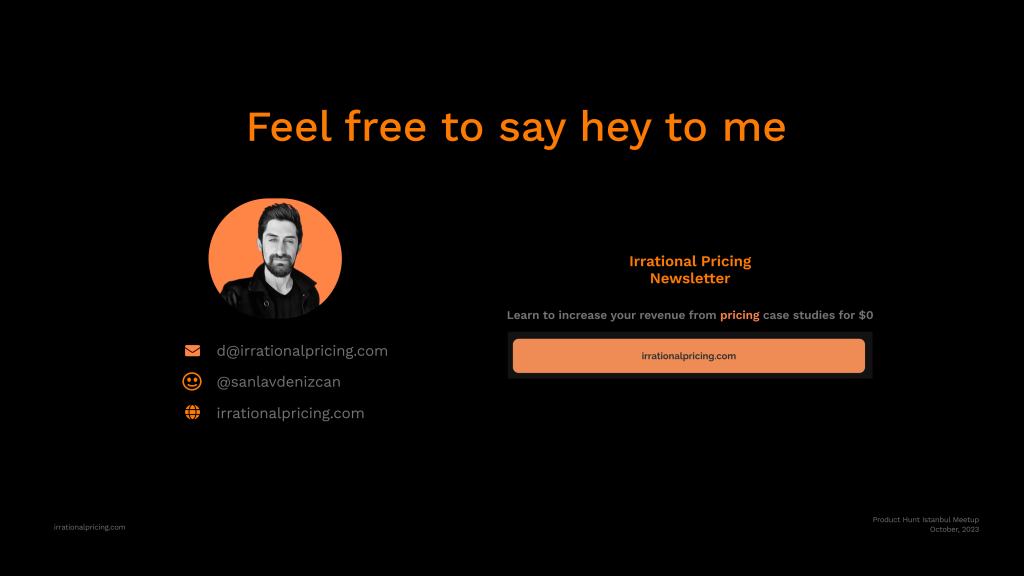
You’re leaving money on the table!
Join 500+ founders who have subscribed to the newsletter.
Join Pricing newsletter and learn from pricing case studies for $0
You can also reach me at irrationalpricing.com and subscribe to my newsletter.
Thank you very much for listening.
Transcript
Intro
0:00
how you design choices determines
0:01
decisions and behaviors when images of
0:04
fliis are placed in urinals men tend to
0:06
aim at them making the restroom cleaner
0:09
I want the user to come in see a
0:11
ridiculously advantageous offer and then
0:14
rationalize it onethird of the users
0:17
were influenced by the default effect
0:19
this has led to a
0:21
135% increase in revenue for not only
0:24
urgency or scarcity works here but also
0:27
the cognitive bias of loss aversion or
0:30
if you offer more than five packages it
0:32
can lead to effects like the Paradox of
0:34
choice making decision making more
0:37
difficult because if they don’t
0:38
rationalize it the likelihood of them
0:40
coming back as unhappy users is very
0:43
high this is the most basic framework
0:45
related to how pricing should be
Who is Denizcan Sanlav?
0:49
[Applause]
0:52
designed today we will focus more on the
0:55
psychology and Behavioral Science
0:57
aspects rather than conventional pricing
0:59
strategy I actually divide myself into
1:02
two different personas one of them is
1:04
related to marketing and pricing while
1:06
the other is focused on product
1:08
development I am on the marketing side
1:10
and together with my developer
1:11
co-founders we are also developing
1:14
products on the right side you can see
1:16
the projects and products I am working
1:18
on now let’s start with a quick question
The psychology of pricing: 2 experiments with nudge and decoy effect
1:21
about pricing psychology what do you
1:24
think about this pricing strategy and
1:26
which one would you
1:28
buy
1:31
in this pricing approach we tend to
1:33
prefer the largest size because these
1:35
prices suggest it the package options
1:38
can be small medium and large but the
1:41
prices below mostly push us to choose
1:43
the largest one this was an example I
Which one would you buy this pricing?
1:46
saw on Twitter let’s imagine Twitter
1:48
implemented the following pricing for
1:50
all users and presented these options
1:52
which one would you
1:55
prefer package one package two or
1:58
package three
2:01
in this scenario package two is the most
2:03
ideal choice because package one is
2:06
quite limited serving as an anchor point
2:08
the second package is highly preferable
2:11
although there isn’t much of a
2:12
difference from the third package to be
2:14
honest therefore the likelihood of
2:16
choosing the second package is much
2:17
higher in this case in Behavioral
Pricing psychology: The impact of behavioral science, psychology, and cognitive biases on human decisions.
2:19
Science and psychology how you design
2:22
choices determines decisions and
2:24
behaviors in essence this is the core of
2:27
the
2:27
matter because one aspect of pricing is
2:30
closely related to
2:32
perception in other words we value
2:34
something based on how we perceive it
2:36
and we assess its price
2:38
accordingly the reason for this is we
Keeping toilets clean with a nudge: The fly in the urinal
2:41
are not rational one of the most ideal
2:43
examples of our irrationality is right
2:45
here some of you might have seen this
2:48
before this was mentioned in the nudge
2:50
book an experiment conducted at
2:53
Amsterdam airport women might not
2:55
understand this because they can be a
2:57
bit surprised when images of fliis are
3:00
placed in urinals men tend to aim at
3:02
them making the restroom cleaner this
3:06
example might seem a bit strange to
3:07
women but it’s true and in this
3:10
experiment it’s actually observed that
3:12
the restroom stays cleaner this way this
3:14
is one of the most common examples of
3:17
nudges another example is from Chicago
Reducing accidents with a nudge: Lane markings on the road
3:20
there are a lot of accidents at a
3:22
particular curve and the local
3:24
authorities their Implement a solution
3:26
like this they make the lane markings as
3:29
you see in the right visual more
3:31
frequent before approaching the curve in
3:33
other words they draw those markings at
3:35
closer
3:36
intervals therefore if I’m going at 70
3:39
km I perceive that I’m going faster
3:42
because the lines are closer together I
3:44
automatically exhibit a reflex to slow
3:47
down therefore they manag to reduce
3:49
accidents by approximately
3:51
36% this is another example of nudging
3:54
that we can
3:56
provide the person who explains this
Daniel Kahneman’s System 1 ve system 2 thinking for pricing
3:58
system best is Daniel Conan he labels
4:01
our brains and our thinking process as
4:03
system one and system two system one is
4:06
our fast thinking side it defines the
System 1 thinking for pricing
4:09
irrational things we do such as emotions
4:11
impulses cognitive biases habits and so
4:14
on system two on the other hand is when
System 2 thinking for pricing
4:18
we think slowly our brain expends more
4:20
energy and we solve more complex
4:23
problems for example when evaluating 10
4:26
different options that’s where we engage
4:28
system to and sometimes it can make
4:31
decision-making difficult due to the
4:32
Paradox of choice because the brain
4:35
expends a lot of energy in those
4:37
situations and most of the time there
4:39
are products that logically work well
How do great products fail?
4:41
but they aren’t liked they don’t grow
4:43
they don’t get bought actually they
4:45
often Market them to system two Jonathan
4:48
ha who explains system 1 and system two
4:51
with the elephant and the writer analogy
4:53
addresses this in his book with this
4:55
analogy he says you can logically
4:58
explain something to system too but that
5:00
doesn’t mean you can move the elephant
5:02
for the emotional impulsive side smoking
5:05
is bad alcohol is bad unhealthy eating
5:08
is bad there’s probably no one here who
5:11
would deny these facts but we can’t
5:13
Implement them so just because something
5:16
is rational doesn’t mean we will do it
5:19
this analogy can serve as an example of
5:21
why some good products don’t succeed
5:23
don’t get
5:24
purchased now let’s continue with a few
Psychological pricing examples – Influence decision of potential customers with framing effect in pricing.
5:27
more examples this is coffee experiment
5:29
I showed you earlier in that scenario we
5:31
was inclined to buy the third package
5:33
meaning the large-sized coffee but if we
5:36
frame these situations differently as
5:38
shown here different outcomes emerge in
5:41
other words the purchase rates change
5:42
for each framing for example if we offer
5:45
to packages one for $5 and another for
5:47
$12 like the top left option it becomes
5:50
a bit more balanced however the $5 small
5:53
sized coffee will be more likely to be
5:55
purchased but if we use a pricing
5:57
strategy like the top right option we
5:59
can see that the $8 medium-sized coffee
6:01
in the middle will be purchased more
6:03
this is what we call the framing effect
6:05
it means we truly perceive the outcomes
6:08
based on how we frame something we can
6:10
influence the results based on how we
6:12
design and present options this is an
6:15
example I saw on product hunt I don’t
Pricing psychology examples 2
6:18
remember the name of the product right
6:19
now but I think it was a video content
6:22
AI tool on the left you can see their
6:24
own pricing they have two packages one
6:27
for $29 and another for $6 $9 they’ve
6:30
designed two different scenarios where
6:32
users can get 60 video exports and
6:34
unlimited video exports this pricing
6:37
strategy is trying to convey the
6:39
following message I actually want to
6:41
sell you the Pro Plan but they don’t
6:42
have a lot of evidence to support this
6:44
argument therefore we tend to decide
Pricing psychology: Usage based decision in pricing and user perception without framing
6:47
based on our usage scenario will I
6:49
export fewer than 60 videos monthly or
6:51
will I export more in other words our
6:53
decision-making tendency is based on
6:55
actual usage however by making a tiny
6:58
nudge to the pricing and designing it
7:00
like the one on the right the results
7:02
can change I added a package next to the
7:04
first one where we can get 100 video
7:06
exports for $59 is it better to pay $69
7:10
for unlimited usage or $59 for 100
7:13
exports this way we make the pro package
7:16
much more advantageous one of the most
7:18
ideal things in pricing is this I want
Pricing psychology: A ridiculously advantageous deal in pricing
7:21
the user to come in see a ridiculously
7:24
advantageous offer and then rationalize
7:27
it most of the time we make decisions
7:30
based on immediate reactions like system
7:33
one thinking but later on we say yes I
Decoy effect and rationalization in pricing decision
7:36
did the right thing this is
7:38
rationalization we tend justifying and
7:40
convincing ourselves about what we did
7:43
therefore an example on the right could
7:45
significantly facilitate the transition
7:47
to the pro package for $59 and we can
7:50
call this the decoy effect this is
7:53
second example this is our product audit
Pricing psychology examples 3: Increased product revenue 135% with default effect in pricing
7:56
we’ve built a product that uses AI based
7:58
technology mentioning AI is essential
8:01
because it’s very popular right now to
8:03
analyze landing page copies we audit
8:06
landing page copies based on behavioral
8:08
and psychological effects on the left
8:11
you can see the pricing section of our
8:12
landing page first let me briefly
Anchoring effect in Pricing psychology
8:15
explain the anchor effect applied here
8:17
we’ve implemented two anchors instead of
8:19
using this tool you could hire a
8:21
consultant for $8,000 alternatively you
8:24
could spend $100,000 to learn this
8:27
information but we say this product is
8:29
only
8:30
$2 it’s worth mentioning that I don’t
8:32
usually recommend low pricing this
8:35
product is the first piece of a series
8:37
of products we will produce we used it
8:39
as a lead magnet so to
8:41
speak that’s why we priced it at
Default effect in Pricing psychology
8:44
$ The crucial Point here is this we’re
8:47
offering this product for $2 on the
8:49
landing page when the user goes to the
8:52
checkout they encounter the stripe
8:53
screen on the right showing
8:56
$13 welcome to the default effect we
8:59
shared this product with our beta users
9:01
first and based on the feedback we
9:03
reached an average willingness to pay of
9:06
$10 we said the product is $ dollars but
9:09
people are paying an average of $13 for
9:12
this product the stripe screen displays
9:15
$13 but you can change it to $2 or any
9:18
other amount we made this study and here
Increased product revenue 135% with pricing psychology and default effect
9:21
are the results of our sales the ones
9:23
marked in yellow are the users who paid
9:25
more than $2 onethird of the users were
9:28
influence Ed by the default effect some
9:31
paid $4 some paid $5 some paid $13 some
9:36
paid $6 and some paid $10 we applied
9:39
this
9:40
method of course it’s important to note
9:43
the sample size here as the sample size
9:46
increases this ratio might decrease now
9:49
we are evaluating based on the current
9:51
situation and I can say it’s 13d of the
9:53
users here’s results for 30 users the
9:56
product is $2 normally we we should have
9:59
earned $60 with 30
10:01
users but with these results we have an
10:04
average revenue of $4.7 per user
10:07
totaling
10:09
$141 this has led to a
10:12
135% increase in Revenue now let’s move
Psychological pricing examples 4: Scarcity bias, Urgency bias and loss aversion bias in Pricing
10:16
on to our final example this case is a
10:18
bit detailed but I’ll focus on one minus
10:21
two critical points because I designed
10:23
this using approximately 10 cognitive
10:25
biases and behavioral effects on the
10:28
left you can see the product itself it’s
10:31
a product that enhances this Twitter
10:33
feed it has an extension which is free
10:35
and can be used with limitations and
10:38
there’s also a pro package I usually
10:40
don’t recommend lifetime deals however
10:43
the friend who developed this product
10:45
opted for this strategy and wants to
10:47
sell it for
10:49
$27 our Target package here is
10:52
$27 we need to make the $27 lifetime
Framing effect in Pricing psychology
10:55
deal much more
10:57
advantageous that that’s why I designed
11:00
the pricing like this you should pay $9
11:03
monthly for this product or you should
11:05
pay $27 monthly for 3 months but you can
11:09
purchase the lifetime deal for
11:11
$27 therefore compared to the existing
11:14
scenario on the left the lifetime option
11:16
on the right becomes much more
11:18
compelling and profitable another
Pricing psychology and BJ Fogg behavior model
11:20
critical point here is the elements we
11:22
see in this section BJ fog is a behavior
11:25
change expert according to his behavior
11:28
change model three elements need to
11:30
align for a person’s Behavior to change
11:33
should be motivated barriers need to be
11:35
removed and thirdly there’s the trigger
11:39
should take action most landing pages
11:41
face a common handicap the user might be
11:44
motivated and we might have removed
11:46
barriers or ambiguity but why should the
11:49
user buy now if we don’t sell to them at
11:52
this moment the hype will fade away this
11:55
situation is a bit different for b2bs we
11:58
can set B to bees aside for this matter
12:00
our main goal is to sell the product
12:02
while the hype is high and the users are
12:04
motivated certainly the call to actions
Pricing psychology: Scarcity bias, Urgency bias and loss aversion bias in Pricing
12:07
is crucial but there are two more
12:09
important aspects the first one is
12:11
urgency bias and the second one is
12:14
scarcity we need to create a sense of
12:17
scarcity and urgency to prompt immediate
12:19
action we are actually creating this at
12:21
the bottom right corner we can call it
12:24
layered pricing specifically inside the
12:26
lifetime deal in the past we sold this
12:29
package to 20 users for $16 now we’re
12:32
selling it for
12:33
$27 however we have limited spots
12:36
available this also acts as a form of
12:39
punishment therefore not only urgency or
12:42
scarcity works here but also the
12:44
cognitive bias of loss aversion the most
12:47
effective cognitive bias we operate on
12:49
is avoiding losses our brain functions
12:51
to Keep Us Alive by avoiding losses so
12:55
we say if you miss out on $27 you’ll
12:58
have to pay
13:00
$49 and there’s a limit to that too in
13:02
The Next Step both the price increases
13:05
and the limit decreases so while making
13:07
the $27 package more appealing to the
13:10
user we simultaneously create urgency
13:12
for them to act now these are two genius
Pricing Mistakes: Mistakes to avoid in your pricing.
13:15
examples I mean they could be very
13:18
genius but you definitely shouldn’t do
13:20
them on the left from Super Pier I don’t
13:24
know how they came up with this pricing
13:26
after how much alcohol but it definitely
13:29
shouldn’t have been done for paid users
13:31
free this actually works on the
13:34
ambiguity bias it serves no purpose
13:36
other than creating confusion the
13:39
example on the right is something we see
13:41
in most S software as a service products
Pricing pages without pricing and Zero risk bias
13:44
it’s another example of what shouldn’t
13:46
be done pricing Pages without pricing
13:49
it’s truly unbelievable I mean why why
13:53
would you put a pricing page without
13:55
pricing I wanted to add these to Common
13:58
examples to help you avoid them there
Pricing psychology: 200+ cognitive biases in pricing
14:00
are more than 200 cognitive biases and
14:03
behavior effect and that’s the most
14:05
important ones especially in the context
14:08
of pricing are these I will share the
14:10
sources shortly if anyone is interested
14:13
in this topic I can also share the
14:15
presentation these are the behavioral
14:17
effects that influence us the most as I
14:20
mentioned they are closely related to
14:22
our perception the value we assign and
14:24
therefore what we are willing to pay now
Pricing psychology: Irrational Pricing framework
14:28
we are in search of a framework in other
14:31
words we are often looking for tricks we
14:34
are searching for methods that work this
14:36
is the most basic framework related to
14:39
how pricing should be designed
14:41
especially for a more value-based
14:43
pricing approach I should also mention
14:46
here that I’m not talking about the
14:48
pricing methods you can find with a
14:49
quick Google search these are examples
14:51
that you won’t often come across ones
14:54
you won’t be able to find easily but
14:56
simple Google searches can yield results
14:58
on class classic pricing methods to
15:00
briefly touch upon the framework first
15:03
choose one package you should have one
15:05
target package in mind I want to sell
15:08
this package to the user later on you
15:11
should have three four or five packages
15:14
having just one or two packages is not
15:16
very ideal because you might not shape
15:18
the pricing packages well
15:20
enough or if you offer more than five
15:23
packages it can lead to effects like the
15:25
Paradox of choice making decision making
15:28
more difficult therefore having three
15:31
four or five packages is ideal and you
15:33
should have one target package and you
15:36
need to make that Target package the one
15:38
you want to sell ridiculously
15:41
advantageous I just explained system 1
15:43
and system 2 a moment ago the user
15:46
should be able to notice this when
15:47
looking at it with system one that is
15:50
immediately the user should think this
15:52
package is very advantageous and I
15:54
shouldn’t miss it this is really a great
15:56
deal and then the user should
15:58
rationalize this decision with system 2
16:01
because if they don’t rationalize it the
16:02
likelihood of them coming back as
16:04
unhappy users is very high as a bonus we
16:07
can also add this I always recommend
16:10
this to those in the product idea or
16:12
development stage take a piece of paper
16:14
and a pen and write a landing page
16:16
because you notice a lot of things while
16:18
writing that landing page what should be
16:20
the unique value proposition of the
16:22
product how should you frame this
16:24
product what are the benefits of this
16:26
product and so on and you get the chance
16:28
to shape the product accordingly in
16:31
addition designing the pricing will make
16:33
your job easier on the technical side so
16:36
first think about how can I sell this
16:38
product and imagine a pricing then it
16:41
will help you develop the product these
16:43
are the resources on the left side there
Research about Pricing psychology
16:46
are books I recommend reading them for
16:49
those interested in these topics there
16:51
are books that Encompass both Behavioral
16:53
Science and marketing on the right side
16:56
there are the trainings I have taken and
16:58
the source I follow you can also reach
Join Irrational Pricing Newsletter at irrationalpricing.com
17:00
me at irrational pricing.com and
17:02
subscribe to my newsletter thank you
17:05
very much for
17:06
Applause
17:14
listening